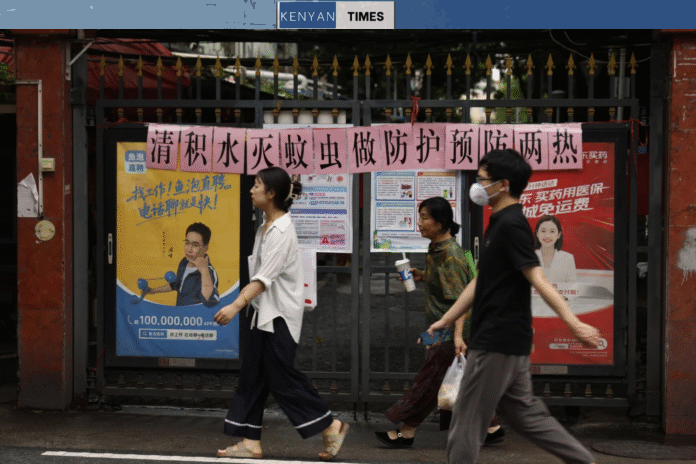🧾 What’s Happening?
- The outbreak began in mid-June, with the earliest case reported on June 16. The peak daily tally reached 681 new cases on July 19. (weekly.chinacdc.cn, TIME)
- Foshan city, especially Shunde District, accounts for 98.5% of cases (4,754 of 4,824 total). Other affected cities include Guangzhou, Shenzhen, Zhongshan, Dongguan and Dongguan. (weekly.chinacdc.cn)
- All cases reported to date have been mild, with no deaths documented. ◆ Symptoms include fever, joint pain, and rash, seen in 65–87% of cases. (weekly.chinacdc.cn)
🏥 Who Is Affected?
- Equal prevalence among men and women (1:0.97 ratio), median age 44 years.
- Adults aged 15–64 constitute over two-thirds of infections; children and elderly account for the rest. (weekly.chinacdc.cn)
🚧 Government Response
- Local authorities in Guangdong have launched strict mosquito-control initiatives, including insecticide spraying, releasing larvae-eating fish, and deploying drones to map breeding sites. (chinadaily.com.cn)
- Public health measures included mandatory hospital isolation, use of mosquito nets, and brief home quarantines—approaches reminiscent of COVID-era tactics. Fines of up to 10,000 yuan and utility shutoffs have been imposed for non-compliance. (pbs.org)
- Authorities have also introduced biological control methods, such as “elephant mosquitoes” that prey on Aedes larvae and 7,000 mosquito‑eating fish released into local water bodies. (mixvale.com.br)
🌍 Regional Spread & Travel Alerts
- Hong Kong recorded its first imported case in 2025: a 12-year-old boy infected during travel to Foshan, now in stable condition. Macao has also reported cases linked to travel. (Hong Kong Free Press HKFP)
- The U.S. CDC has issued a Level 2 travel advisory for Guangdong province. Travelers are urged to use insect repellent, protective clothing, and avoid mosquito-rich areas. (AP News, as.com, The Washington Post)
⚠️ Expert Warnings & Underlying Causes
- Researchers cite heavy monsoon rains, rising temperatures, and urban climate conditions, which foster abundant mosquito breeding. (financialexpress.com, economictimes.indiatimes.com)
- According to WHO, chikungunya outbreaks are increasingly common globally and linked to climate change, urbanization, and increased travel, with over 220,000 cases reported across 14 countries in 2025 alone. (financialexpress.com)
🧩 Quick Facts at a Glance
| Item | Details |
|---|---|
| Total Cases | Over 7,000 confirmed (mostly in Foshan) |
| Period of Outbreak | Began mid-June; peaked July 19 |
| Most Affected | Foshan’s Shunde District (98.5% of all provincial cases) |
| Symptoms | Fever, joint pain, rash; mostly mild conditions |
| Fatalities | Zero reported deaths |
| Control Actions | Insect sprays, netting, fines, drones, biological agents |
| Imported Cases | Detected in Hong Kong and Macao |
| Traveler Alerts | U.S. CDC Level 2 advisory for Guangdong |
📝 Health Guidance & Prevention
- Watch for key symptoms: high fever, debilitating joint pain, rash, headache, fatigue. Seek medical attention if symptoms appear 3–7 days post-bite. (AP News, youtube.com, weekly.chinacdc.cn, The Washington Post, financialexpress.com)
- Protect yourself: Use mosquito repellents (DEET, picaridin), wear light long sleeves, sleep under nets, and eliminate standing water around homes. (financialexpress.com)
- Global reminder: While rare in China historically, chikungunya is a persistent threat in many regions and not spread person-to-person—mosquito control remains the best defense.
This outbreak underscores how quickly a mosquito-borne virus can escalate in urban settings—especially amid environmental change. Though chikungunya doesn’t spread between people, its potential for intense joint pain and large-scale regional outbreaks means vigilance and swift public health action are essential.




